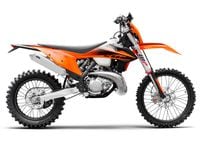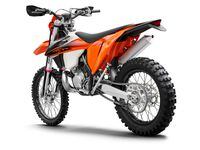The KTM 250 XC-W TPI was one of two of the Austrian manufacturer’s first production versions of its fuel-injected two-stroke enduro bike; the other being its larger-displacement sibling, the 300 XC-W TPI. The 250 XC-W TPI first hit the United States and European market in 2018, while the 300 XC-W TPI was only available in Europe in 2018 and did not come stateside until 2019. With its 249cc displacement engine featuring Transfer Port Injection (TPI), the 250 XC-W TPI is an ideal choice for an enduro rider who wants a two-stroke that doesn’t have quite as much torque as a 300, and doesn’t want to premix fuel.
When KTM calls asking if you want to test its new fuel-injected two-stroke enduro bike at Erzberg, the site of the world-renowned Erzberg Rodeo extreme enduro race, you grab your gear bag and hop on the next flight to Austria. That is exactly what we did in 2018, chock-full of curiosity about how the TPI engine would perform. During our day of riding at the mine, one of the aspects we observed about the 250 XC-W TPI was its ability to run at an unusually low rpm, which made navigating tight switchback turns easy.
If you like most aspects about the KTM 250 XC-W TPI, but would prefer a bike with suspension linkage, the Husqvarna TE 250i may be the perfect option. Additional competition for the 250 XC-W TPI would include the TM EN 250 Fi ES 2T, Beta 250 RR, Sherco 250 SE-R, and Yamaha YZ250X. At $9,799, the 250 XC-W TPI is $100 more than the TE 250i, $4 more than the EN 250 Fi ES, $1,000 more than the 250 RR, $600 more than the 250 SE-R, and $2,200 more than the YZ250X.
KTM’s 250cc fuel-injected two-stroke enduro model enjoys a host of changes for 2020, the most prominent of which include a stiffer frame, new bodywork, updated suspension settings, a new airbox, revised mapping, and a new six-speed transmission made by Pankl.


/cloudfront-us-east-1.images.arcpublishing.com/octane/FNHXQQ56BRD7TO4YIJ453PNG2M.jpg)
/cloudfront-us-east-1.images.arcpublishing.com/octane/OIKJC4JA3ZH7BMKUGWYKBIY5FA.jpg)
/cloudfront-us-east-1.images.arcpublishing.com/octane/MT2SAEWY6FDXFBYSLDE3AEFDTM.jpg)
/cloudfront-us-east-1.images.arcpublishing.com/octane/66UPKPYVURBPRCP5HXSN56MEMM.jpg)
/cloudfront-us-east-1.images.arcpublishing.com/octane/EOREGDSRKFDCRJC6K3EDVHBGCE.jpg)
/cloudfront-us-east-1.images.arcpublishing.com/octane/42RF63Q3LVCMBP3DGTWXFYSMOA.jpg)
/cloudfront-us-east-1.images.arcpublishing.com/octane/XNVY3EVWZFCEVPUGJGAN633LXE.jpg)
/cloudfront-us-east-1.images.arcpublishing.com/octane/2PLTVHXY7FDSPFHKU5CFOC43ZY.jpg)
/cloudfront-us-east-1.images.arcpublishing.com/octane/B6M3WTRLFZGNXBEATNXPVGBBD4.jpg)
/cloudfront-us-east-1.images.arcpublishing.com/octane/4CMH3FI73BEM5D6MFYX42FLDSQ.jpg)
/cloudfront-us-east-1.images.arcpublishing.com/octane/RIHAPYNWU5H3XAOXNOPRWCBTQA.jpg)
/cloudfront-us-east-1.images.arcpublishing.com/octane/HU4NUBCL3VAFZA75VYRCMAUHVM.jpg)
/cloudfront-us-east-1.images.arcpublishing.com/octane/OB43AZK7TRA6XLZL5WRDVW2TDA.jpg)
/cloudfront-us-east-1.images.arcpublishing.com/octane/5G44Y3FXWNFSTEQKCA355PXOPU.jpg)

/cloudfront-us-east-1.images.arcpublishing.com/octane/XRI4GTLCVBA5NESASCBIR5LYQI.jpg)
/cloudfront-us-east-1.images.arcpublishing.com/octane/EF7566PXARGMBAOMLWTECYL3LE.jpg)





/cloudfront-us-east-1.images.arcpublishing.com/octane/3LASNXSWUZFFPISURDJF3OCWBU.jpg)
/cloudfront-us-east-1.images.arcpublishing.com/octane/2BHJKWUTBNBTLMQCKDNVEG6DKQ.jpg)